2013 NISSAN PATHFINDER ad blue
[x] Cancel search: ad bluePage 4 of 506
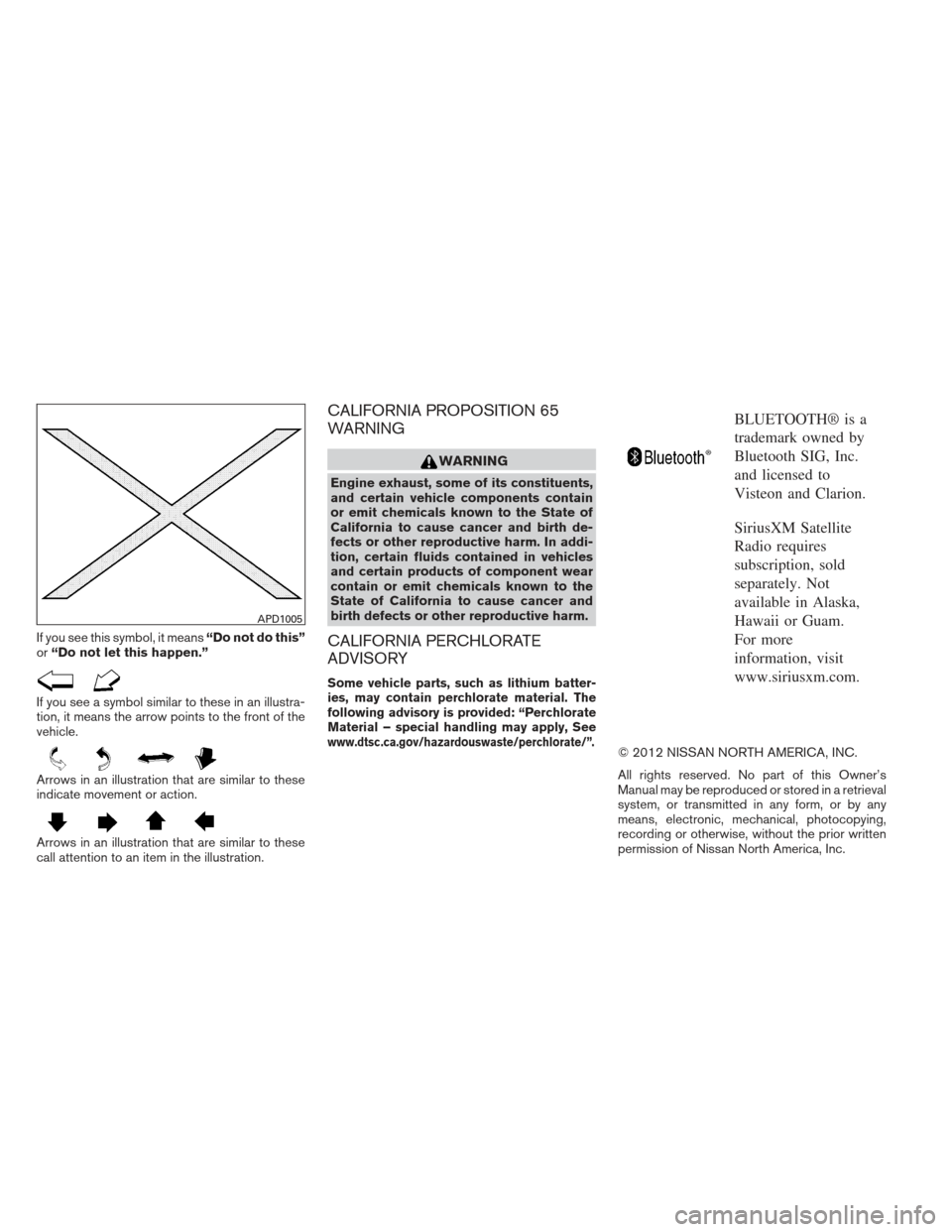
If you see this symbol, it means“Do not do this”
or “Do not let this happen.”
If you see a symbol similar to these in an illustra-
tion, it means the arrow points to the front of the
vehicle.
Arrows in an illustration that are similar to these
indicate movement or action.
Arrows in an illustration that are similar to these
call attention to an item in the illustration.
CALIFORNIA PROPOSITION 65
WARNING
WARNING
Engine exhaust, some of its constituents,
and certain vehicle components contain
or emit chemicals known to the State of
California to cause cancer and birth de-
fects or other reproductive harm. In addi-
tion, certain fluids contained in vehicles
and certain products of component wear
contain or emit chemicals known to the
State of California to cause cancer and
birth defects or other reproductive harm.
CALIFORNIA PERCHLORATE
ADVISORY
Some vehicle parts, such as lithium batter-
ies, may contain perchlorate material. The
following advisory is provided: “Perchlorate
Material – special handling may apply, See
www.dtsc.ca.gov/hazardouswaste/perchlorate/”.
BLUETOOTH® is a
trademark owned by
Bluetooth SIG, Inc.
and licensed to
Visteon and Clarion.
SiriusXM Satellite
Radio requires
subscription, sold
separately. Not
available in Alaska,
Hawaii or Guam.
For more
information, visit
www.siriusxm.com.
© 2012 NISSAN NORTH AMERICA, INC.
All rights reserved. No part of this Owner’s
Manual may be reproduced or stored in a retrieval
system, or transmitted in any form, or by any
means, electronic, mechanical, photocopying,
recording or otherwise, without the prior written
permission of Nissan North America, Inc.
APD1005
Page 13 of 506
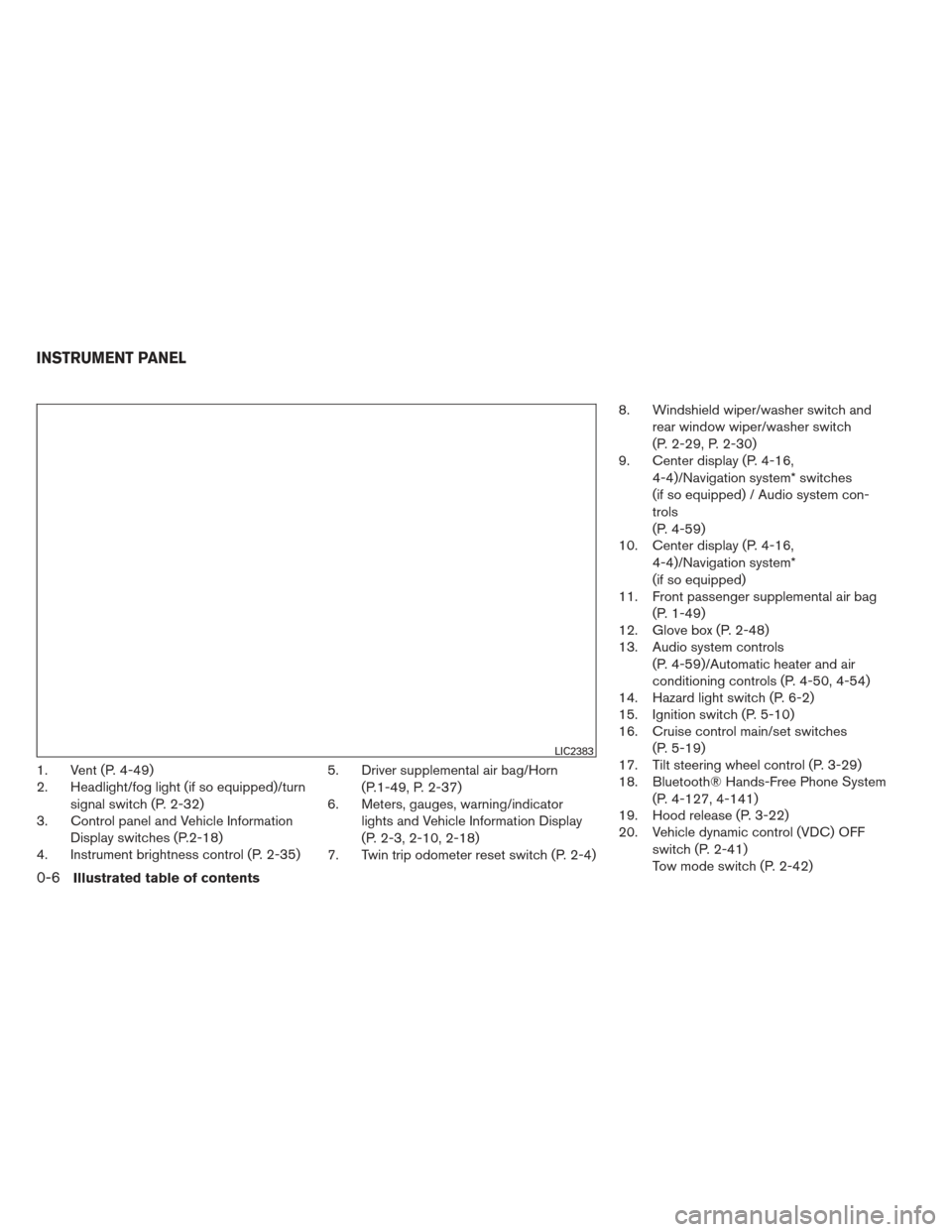
1. Vent (P. 4-49)
2. Headlight/fog light (if so equipped)/turnsignal switch (P. 2-32)
3. Control panel and Vehicle Information
Display switches (P.2-18)
4. Instrument brightness control (P. 2-35) 5. Driver supplemental air bag/Horn
(P.1-49, P. 2-37)
6. Meters, gauges, warning/indicator
lights and Vehicle Information Display
(P. 2-3, 2-10, 2-18)
7. Twin trip odometer reset switch (P. 2-4) 8. Windshield wiper/washer switch and
rear window wiper/washer switch
(P. 2-29, P. 2-30)
9. Center display (P. 4-16,
4-4)/Navigation system* switches
(if so equipped) / Audio system con-
trols
(P. 4-59)
10. Center display (P. 4-16,
4-4)/Navigation system*
(if so equipped)
11. Front passenger supplemental air bag
(P. 1-49)
12. Glove box (P. 2-48)
13. Audio system controls
(P. 4-59)/Automatic heater and air
conditioning controls (P. 4-50, 4-54)
14. Hazard light switch (P. 6-2)
15. Ignition switch (P. 5-10)
16. Cruise control main/set switches
(P. 5-19)
17. Tilt steering wheel control (P. 3-29)
18. Bluetooth® Hands-Free Phone System
(P. 4-127, 4-141)
19. Hood release (P. 3-22)
20. Vehicle dynamic control (VDC) OFF
switch (P. 2-41)
Tow mode switch (P. 2-42)
LIC2383
INSTRUMENT PANEL
0-6Illustrated table of contents
Page 16 of 506
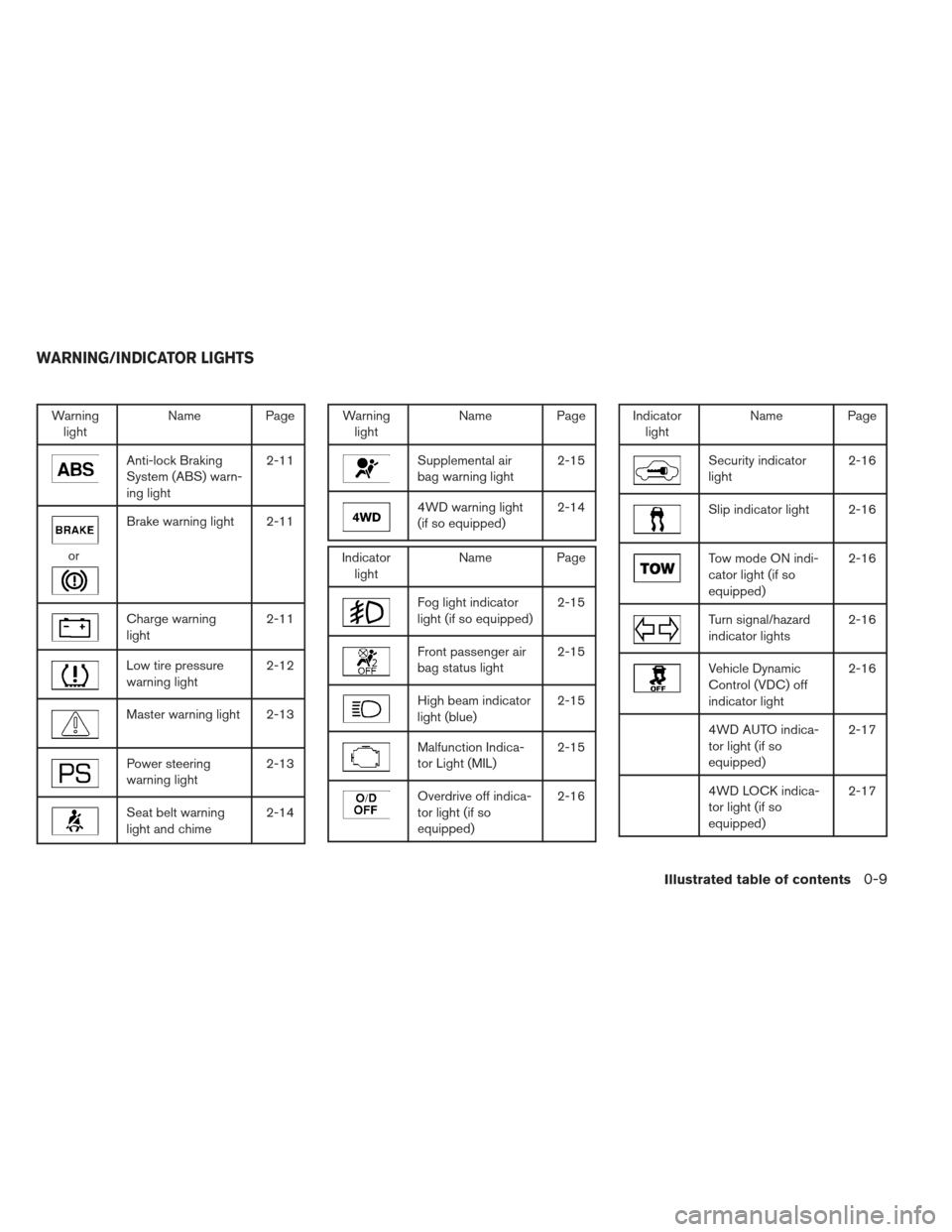
Warninglight Name Page
Anti-lock Braking
System (ABS) warn-
ing light 2-11
or
Brake warning light 2-11
Charge warning
light
2-11
Low tire pressure
warning light2-12
Master warning light 2-13
Power steering
warning light2-13
Seat belt warning
light and chime2-14
Warning
light Name Page
Supplemental air
bag warning light 2-15
4WD warning light
(if so equipped)2-14
Indicator
light Name Page
Fog light indicator
light (if so equipped) 2-15
Front passenger air
bag status light2-15
High beam indicator
light (blue)2-15
Malfunction Indica-
tor Light (MIL)2-15
Overdrive off indica-
tor light (if so
equipped)2-16
Indicator
light Name Page
Security indicator
light 2-16
Slip indicator light 2-16
Tow mode ON indi-
cator light (if so
equipped)2-16
Turn signal/hazard
indicator lights
2-16
Vehicle Dynamic
Control (VDC) off
indicator light2-16
4WD AUTO indica-
tor light (if so
equipped)2-17
4WD LOCK indica-
tor light (if so
equipped)2-17
WARNING/INDICATOR LIGHTS
Illustrated table of contents0-9
Page 85 of 506
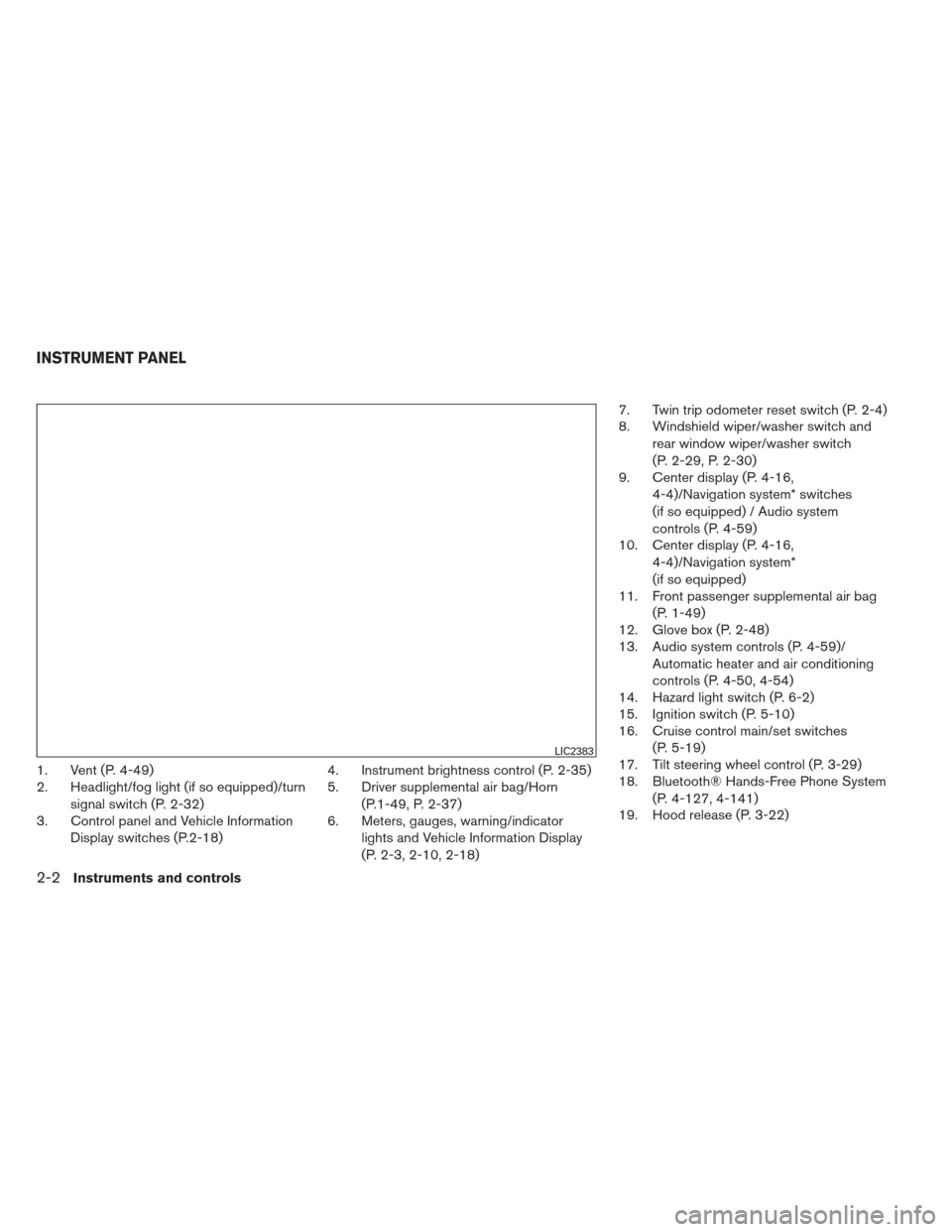
1. Vent (P. 4-49)
2. Headlight/fog light (if so equipped)/turnsignal switch (P. 2-32)
3. Control panel and Vehicle Information
Display switches (P.2-18) 4. Instrument brightness control (P. 2-35)
5. Driver supplemental air bag/Horn
(P.1-49, P. 2-37)
6. Meters, gauges, warning/indicator
lights and Vehicle Information Display
(P. 2-3, 2-10, 2-18) 7. Twin trip odometer reset switch (P. 2-4)
8. Windshield wiper/washer switch and
rear window wiper/washer switch
(P. 2-29, P. 2-30)
9. Center display (P. 4-16,
4-4)/Navigation system* switches
(if so equipped) / Audio system
controls (P. 4-59)
10. Center display (P. 4-16,
4-4)/Navigation system*
(if so equipped)
11. Front passenger supplemental air bag
(P. 1-49)
12. Glove box (P. 2-48)
13. Audio system controls (P. 4-59)/
Automatic heater and air conditioning
controls (P. 4-50, 4-54)
14. Hazard light switch (P. 6-2)
15. Ignition switch (P. 5-10)
16. Cruise control main/set switches
(P. 5-19)
17. Tilt steering wheel control (P. 3-29)
18. Bluetooth® Hands-Free Phone System
(P. 4-127, 4-141)
19. Hood release (P. 3-22)
LIC2383
INSTRUMENT PANEL
2-2Instruments and controls
Page 93 of 506
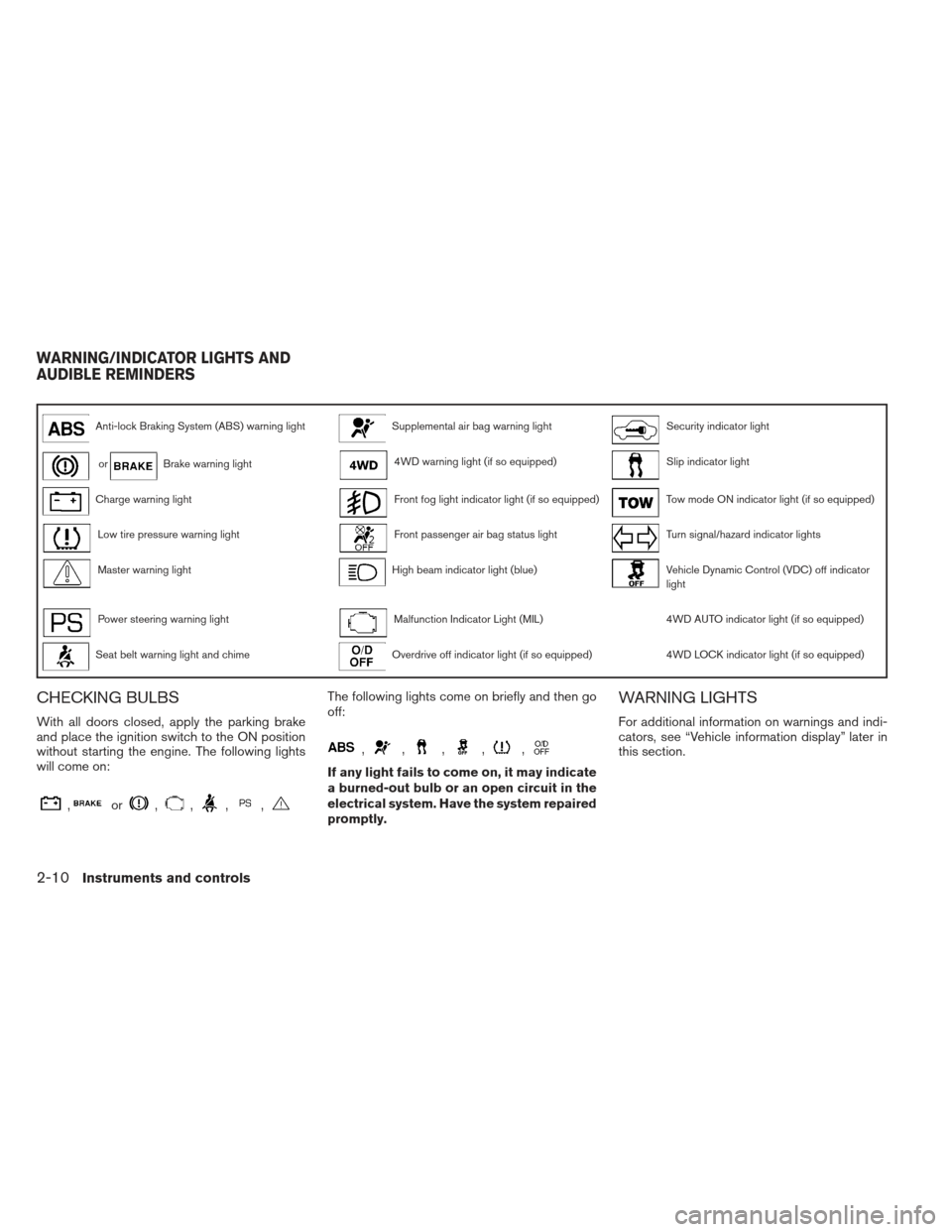
Anti-lock Braking System (ABS) warning lightSupplemental air bag warning lightSecurity indicator light
orBrake warning light4WD warning light (if so equipped)Slip indicator light
Charge warning lightFront fog light indicator light (if so equipped)Tow mode ON indicator light (if so equipped)
Low tire pressure warning lightFront passenger air bag status lightTurn signal/hazard indicator lights
Master warning lightHigh beam indicator light (blue)Vehicle Dynamic Control (VDC) off indicator
light
Power steering warning lightMalfunction Indicator Light (MIL)4WD AUTO indicator light (if so equipped)
Seat belt warning light and chimeOverdrive off indicator light (if so equipped)4WD LOCK indicator light (if so equipped)
CHECKING BULBS
With all doors closed, apply the parking brake
and place the ignition switch to the ON position
without starting the engine. The following lights
will come on:
,or,,,,
The following lights come on briefly and then go
off:
,,,,,
If any light fails to come on, it may indicate
a burned-out bulb or an open circuit in the
electrical system. Have the system repaired
promptly.
WARNING LIGHTS
For additional information on warnings and indi-
cators, see “Vehicle information display” later in
this section.
WARNING/INDICATOR LIGHTS AND
AUDIBLE REMINDERS
2-10Instruments and controls
Page 98 of 506
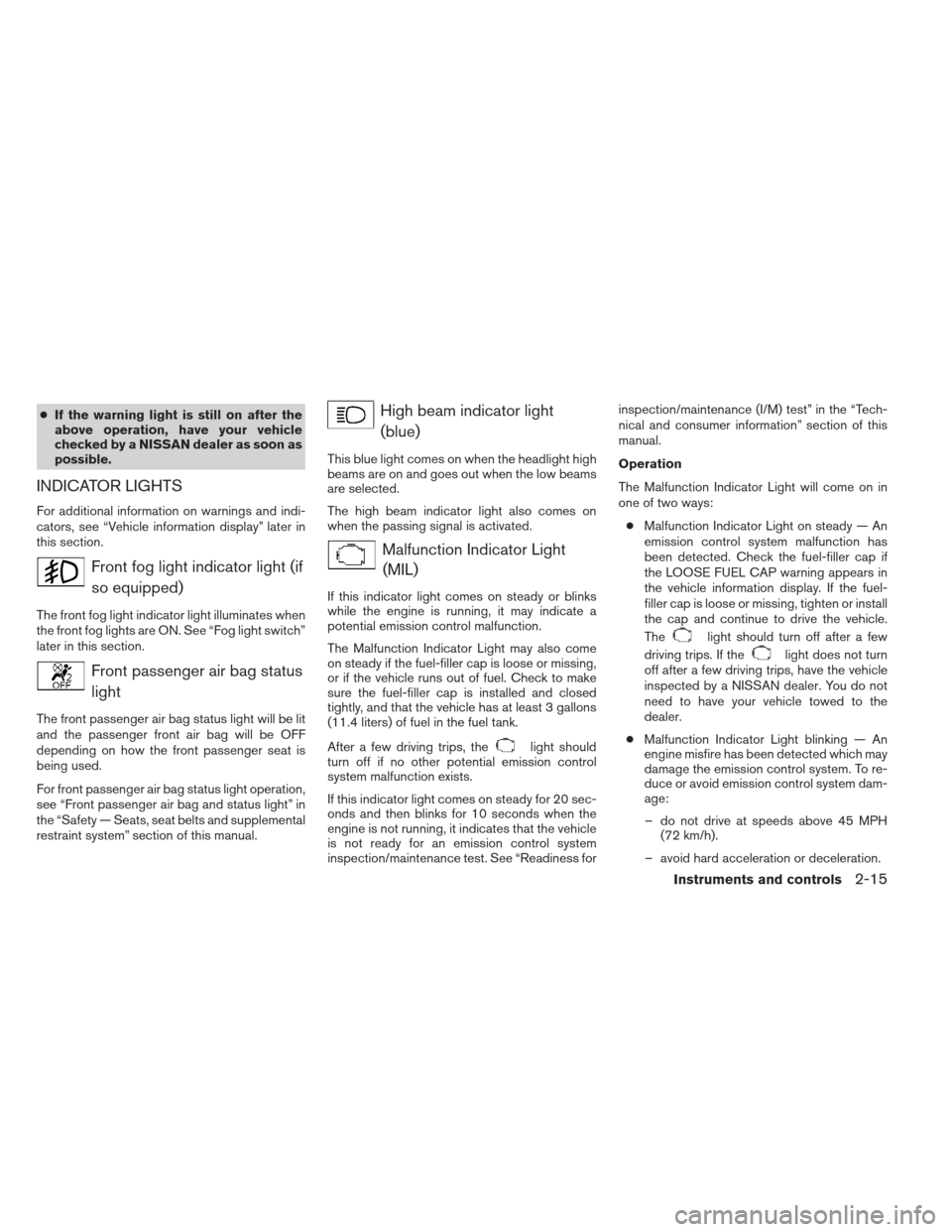
●If the warning light is still on after the
above operation, have your vehicle
checked by a NISSAN dealer as soon as
possible.
INDICATOR LIGHTS
For additional information on warnings and indi-
cators, see “Vehicle information display” later in
this section.
Front fog light indicator light (if
so equipped)
The front fog light indicator light illuminates when
the front fog lights are ON. See “Fog light switch”
later in this section.
Front passenger air bag statuslight
The front passenger air bag status light will be lit
and the passenger front air bag will be OFF
depending on how the front passenger seat is
being used.
For front passenger air bag status light operation,
see “Front passenger air bag and status light” in
the “Safety — Seats, seat belts and supplemental
restraint system” section of this manual.
High beam indicator light(blue)
This blue light comes on when the headlight high
beams are on and goes out when the low beams
are selected.
The high beam indicator light also comes on
when the passing signal is activated.
Malfunction Indicator Light(MIL)
If this indicator light comes on steady or blinks
while the engine is running, it may indicate a
potential emission control malfunction.
The Malfunction Indicator Light may also come
on steady if the fuel-filler cap is loose or missing,
or if the vehicle runs out of fuel. Check to make
sure the fuel-filler cap is installed and closed
tightly, and that the vehicle has at least 3 gallons
(11.4 liters) of fuel in the fuel tank.
After a few driving trips, the
light should
turn off if no other potential emission control
system malfunction exists.
If this indicator light comes on steady for 20 sec-
onds and then blinks for 10 seconds when the
engine is not running, it indicates that the vehicle
is not ready for an emission control system
inspection/maintenance test. See “Readiness for inspection/maintenance (I/M) test” in the “Tech-
nical and consumer information” section of this
manual.
Operation
The Malfunction Indicator Light will come on in
one of two ways:
● Malfunction Indicator Light on steady — An
emission control system malfunction has
been detected. Check the fuel-filler cap if
the LOOSE FUEL CAP warning appears in
the vehicle information display. If the fuel-
filler cap is loose or missing, tighten or install
the cap and continue to drive the vehicle.
The
light should turn off after a few
driving trips. If the
light does not turn
off after a few driving trips, have the vehicle
inspected by a NISSAN dealer. You do not
need to have your vehicle towed to the
dealer.
● Malfunction Indicator Light blinking — An
engine misfire has been detected which may
damage the emission control system. To re-
duce or avoid emission control system dam-
age:
– do not drive at speeds above 45 MPH (72 km/h).
– avoid hard acceleration or deceleration.
Instruments and controls2-15
Page 193 of 506
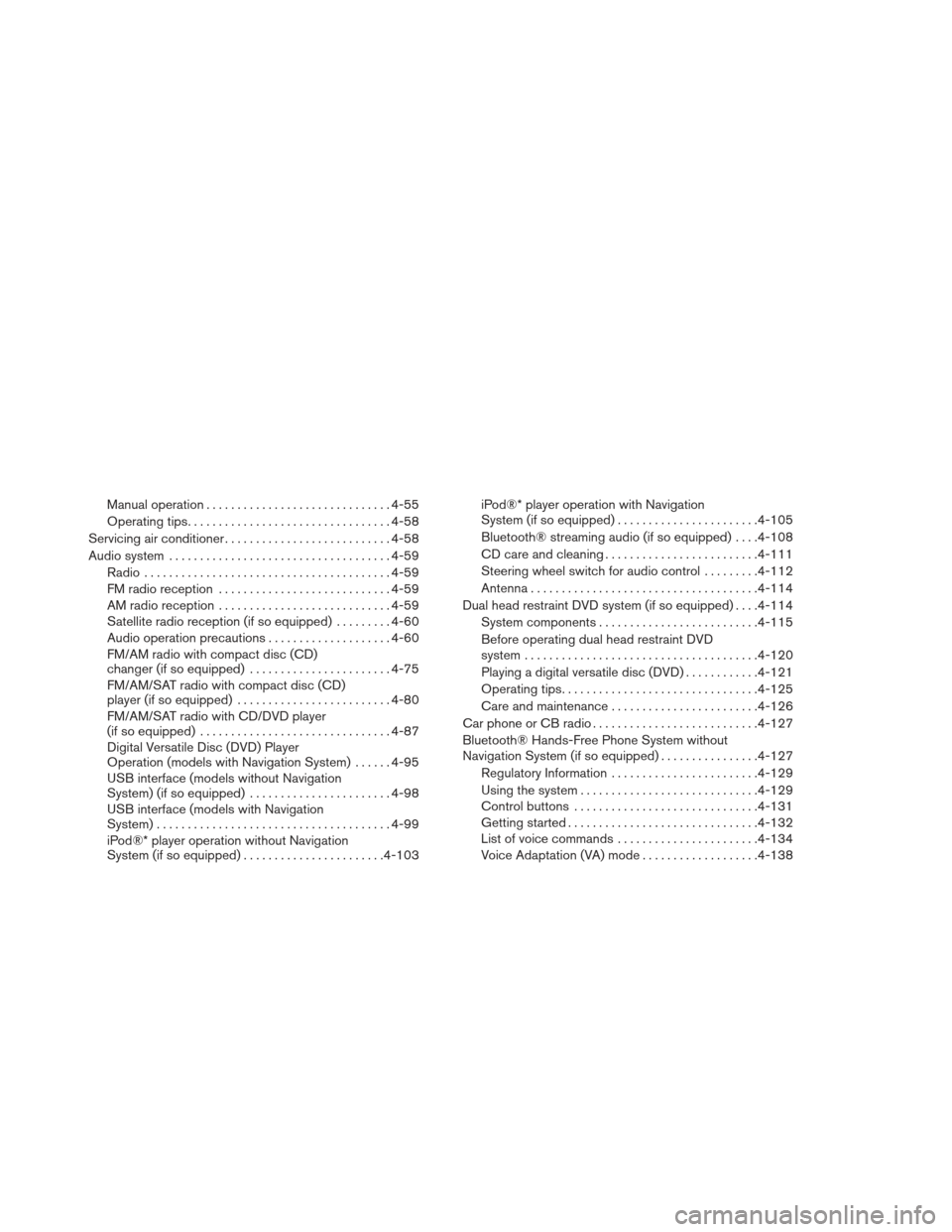
Manual operation.............................. 4-55
Operating tips ................................. 4-58
Servicing air conditioner ........................... 4-58
Audio system .................................... 4-59
Radio ........................................ 4-59
FM radio reception . . .......................... 4-59
AM radio reception . . .......................... 4-59
Satellite radio reception (if so equipped) .........4-60
Audio operation precautions ....................4-60
FM/AM radio with compact disc (CD)
changer (if so equipped) .......................4-75
FM/AM/SAT radio with compact disc (CD)
player (if so equipped) ......................... 4-80
FM/AM/SAT radio with CD/DVD player
(if so equipped) ............................... 4-87
Digital Versatile Disc (DVD) Player
Operation (models with Navigation System) ......4-95
USB interface (models without Navigation
System) (if so equipped) .......................4-98
USB interface (models with Navigation
System) ...................................... 4-99
iPod®* player operation without Navigation
System (if so equipped) ....................... 4-103iPod®* player operation with Navigation
System (if so equipped)
....................... 4-105
Bluetooth® streaming audio (if so equipped) ....4-108
CD care and cleaning ......................... 4-111
Steering wheel switch for audio control .........4-112
Antenna ..................................... 4-114
Dual head restraint DVD system (if so equipped) ....4-114
System components .......................... 4-115
Before operating dual head restraint DVD
system ...................................... 4-120
Playing a digital versatile disc (DVD) ............4-121
Operating tips ................................ 4-125
Care and maintenance ........................ 4-126
Car phone or CB radio ........................... 4-127
Bluetooth® Hands-Free Phone System without
Navigation System (if so equipped) ................4-127
Regulatory Information ........................ 4-129
Using the system ............................. 4-129
Control
buttons .............................. 4-131
Getting started ............................... 4-132
List of voice commands ....................... 4-134
Voice Adaptation (VA) mode ...................4-138
Page 194 of 506
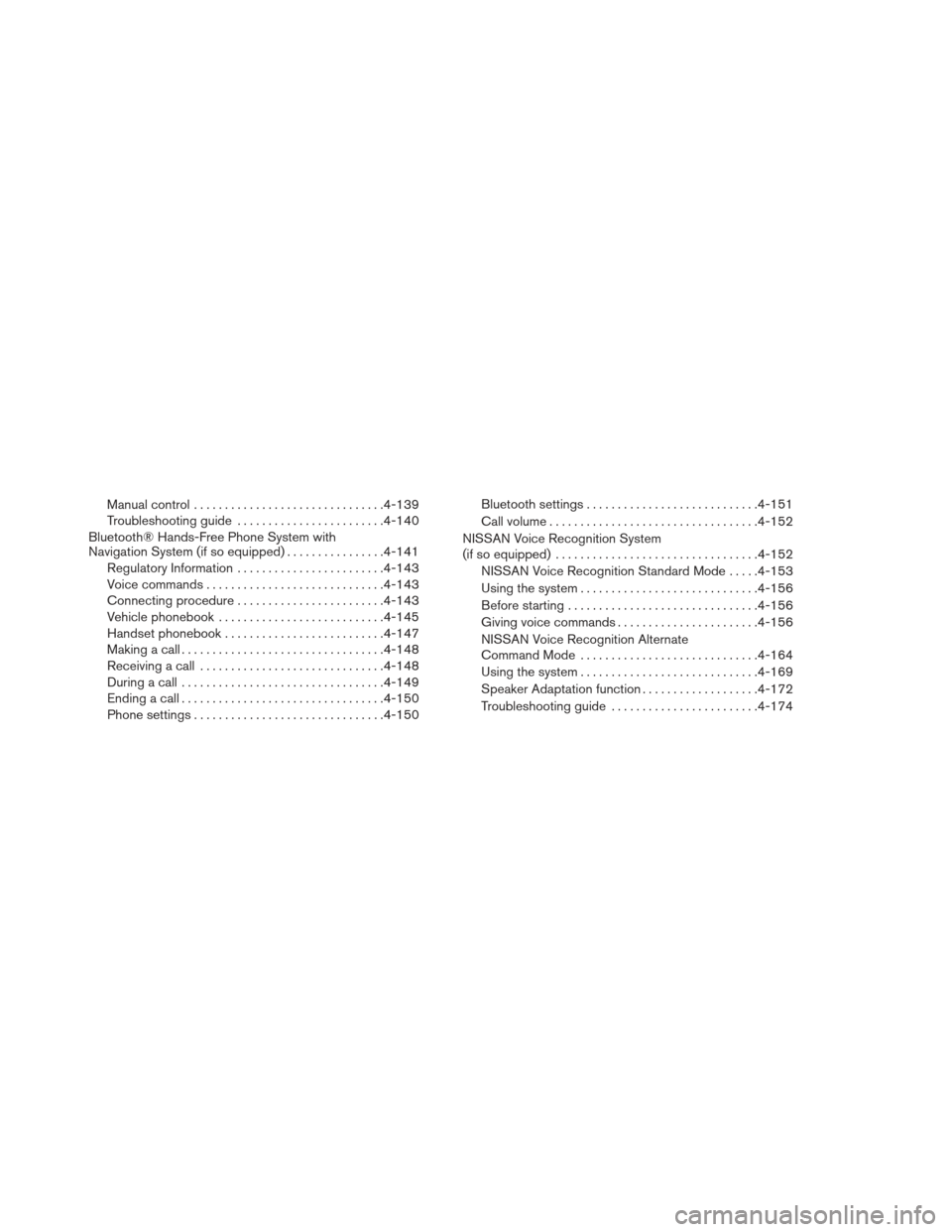
Manual control............................... 4-139
Troubleshooting guide ........................ 4-140
Bluetooth® Hands-Free Phone System with
Navigation System (if so equipped) ................4-141
Regulatory Information ........................ 4-143
Voice commands ............................. 4-143
Connecting procedure ........................ 4-143
Vehicle phonebook ........................... 4-145
Handset phonebook .......................... 4-147
Making a call ................................. 4-148
Receiving a call .............................. 4-148
During a call ................................. 4-149
Ending a call ................................. 4-150
Phone settings ............................... 4-150Bluetooth settings
............................ 4-151
Call volume .................................. 4-152
NISSAN Voice Recognition System
(if so equipped) . . . .............................. 4-152
NISSAN Voice Recognition Standard Mode .....4-153
Using the system ............................. 4-156
Before starting ............................... 4-156
Giving voice commands ....................... 4-156
NISSAN Voice Recognition Alternate
Command Mode ............................. 4-164
Using the system ............................. 4-169
Speaker Adaptation function ...................4-172
Troubleshooting guide ........................ 4-174